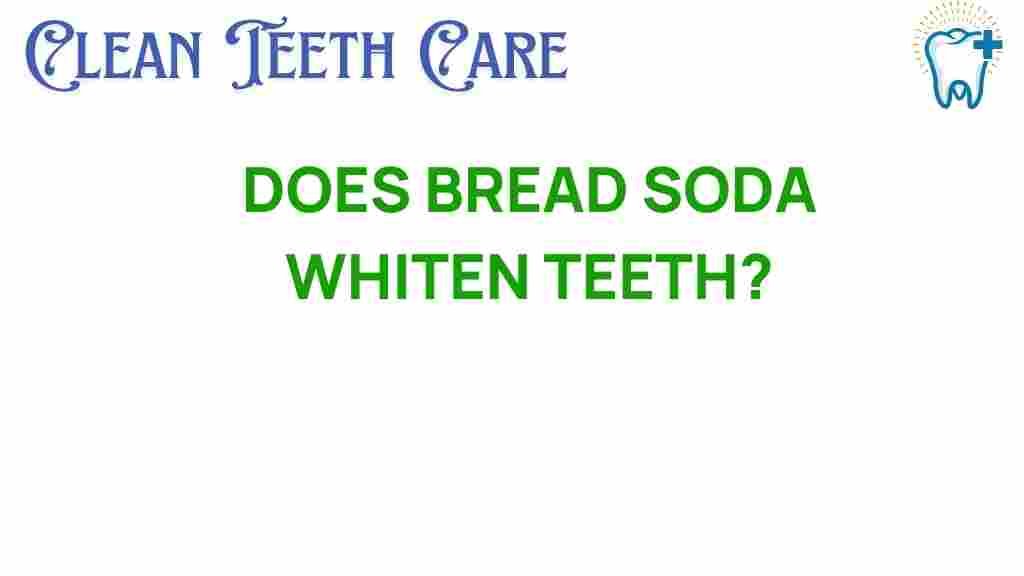Can Bread Soda Really Whiten Your Teeth?
The pursuit of a bright, white smile has led many to explore various teeth whitening methods. One common household item, bread soda, also known as baking soda, is often touted as an effective natural remedy for achieving whiter teeth. But does it really work? In this article, we will delve into the surprising truth about bread soda and its effectiveness in teeth whitening, exploring the science behind whitening, its role in dental care, and how it fits into your overall oral health routine.
The Science Behind Whitening
Understanding how whitening agents work is crucial in evaluating the effectiveness of any home treatments, including bread soda. Whitening products generally function by:
- Removing Surface Stains: Many whitening agents contain abrasives that help scrub away stains caused by food and drinks.
- Bleaching Teeth: Some products contain peroxide-based compounds that penetrate the enamel and lighten the color of the teeth.
Baking soda falls into the first category. It is mildly abrasive and can effectively remove surface stains from your teeth, thus contributing to a whiter appearance. However, it does not contain any bleaching agents, meaning it may not be as effective for deeper stains.
Benefits of Using Bread Soda for Teeth Whitening
Using bread soda for teeth whitening has several benefits:
- Natural Remedy: It is a common household item and provides a natural alternative to commercial whitening products.
- Cost-Effective: Bread soda is inexpensive compared to many dental treatments.
- Easy to Use: Incorporating baking soda into your dental hygiene routine is simple and straightforward.
How to Use Bread Soda for Teeth Whitening
Here’s a step-by-step guide on how to use bread soda for teeth whitening:
Step 1: Gather Your Materials
You will need:
- 1 teaspoon of bread soda (baking soda)
- A few drops of water or lemon juice
- Your regular toothbrush
Step 2: Prepare the Mixture
In a small bowl, mix the baking soda with just enough water or lemon juice to form a paste. The paste should be thick enough to stick to your toothbrush without dripping.
Step 3: Apply to Your Teeth
Dip your toothbrush into the paste and gently brush your teeth for about two minutes. Be sure to focus on stained areas, but avoid excessive scrubbing, as baking soda can be abrasive.
Step 4: Rinse Thoroughly
After brushing, rinse your mouth thoroughly with water to remove all remnants of the baking soda paste.
Frequency of Use
To avoid damaging your enamel, it’s recommended to use bread soda for teeth whitening no more than once or twice a week. Overuse can lead to enamel erosion and increased tooth sensitivity.
Potential Risks and Troubleshooting Tips
While using bread soda can be beneficial, there are some risks and troubleshooting tips to keep in mind:
- Enamel Erosion: Over-brushing or using baking soda too frequently can wear down your enamel. Always monitor your teeth for sensitivity.
- Gum Irritation: If you experience any irritation, discontinue use and consult a dentist.
- Staining from Other Sources: While baking soda can help remove stains, it won’t prevent new stains from forming. Regular dental hygiene is essential.
Integrating Baking Soda into Your Dental Hygiene Routine
Incorporating bread soda into your dental hygiene routine is just one component of maintaining good oral health. Here are some additional tips:
- Brush Twice Daily: Regular brushing with fluoride toothpaste is crucial for removing plaque and preventing cavities.
- Floss Daily: Flossing helps remove food particles and plaque from between the teeth, where your toothbrush may not reach.
- Regular Dental Visits: Schedule check-ups with your dentist every six months for professional cleanings and assessments.
- Healthy Diet: Limit sugary snacks and beverages, as they can contribute to tooth decay and staining.
Other Natural Remedies for Teeth Whitening
If you’re interested in natural remedies beyond bread soda, consider the following options:
- Activated Charcoal: Some people use activated charcoal as a whitening agent, but it should be used cautiously due to its abrasive nature.
- Coconut Oil Pulling: Swishing coconut oil in your mouth may help reduce plaque and improve oral health.
- Strawberries: Some claim that the malic acid in strawberries can help whiten teeth, though results may vary.
Always remember to consult with your dentist before trying any new home treatments for teeth whitening to ensure they are safe and suitable for your individual dental health.
Conclusion
In conclusion, bread soda can indeed help whiten your teeth by removing surface stains due to its abrasive properties. However, it is not a comprehensive solution for all types of stains and should be used sparingly to protect your enamel. For optimal dental hygiene, combine bread soda with regular brushing, flossing, and dental check-ups. Always prioritize your oral health and consider consulting a dental professional if you’re looking for more effective whitening solutions.
For more information on maintaining good oral hygiene and exploring effective dental care practices, check out this resource.
Remember, a bright smile is not just about whitening; it’s about overall health and care. Embrace a routine that works best for you!
This article is in the category Treatments and created by CleanTeethCare Team
